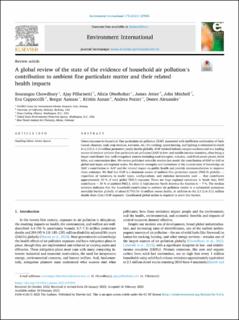A global review of the state of the evidence of household air pollution's contribution to ambient fine particulate matter and their related health impacts
| dc.contributor.author | Chowdhury, Sourangsu | |
| dc.contributor.author | Pillarisetti, Ajay | |
| dc.contributor.author | Oberholzer, Alicia | |
| dc.contributor.author | Jetter, James | |
| dc.contributor.author | Mitchell, John | |
| dc.contributor.author | Cappuccilli, Eva | |
| dc.contributor.author | Aamaas, Borgar | |
| dc.contributor.author | Aunan, Kristin | |
| dc.contributor.author | Pozzer, Andrea | |
| dc.contributor.author | Alexander, Donee | |
| dc.date.accessioned | 2024-02-22T09:02:47Z | |
| dc.date.available | 2024-02-22T09:02:47Z | |
| dc.date.created | 2023-03-07T10:51:05Z | |
| dc.date.issued | 2023 | |
| dc.identifier.issn | 0160-4120 | |
| dc.identifier.uri | https://hdl.handle.net/11250/3119197 | |
| dc.description.abstract | Direct exposure to household fine particulate air pollution (HAP) associated with inefficient combustion of fuels (wood, charcoal, coal, crop residues, kerosene, etc.) for cooking, space-heating, and lighting is estimated to result in 2.3 (1.6–3.1) million premature yearly deaths globally. HAP emitted indoors escapes outdoors and is a leading source of outdoor ambient fine particulate air pollution (AAP) in low- and middle-income countries, often being a larger contributor than well-recognized sources including road transport, industry, coal-fired power plants, brick kilns, and construction dust. We review published scientific studies that model the contribution of HAP to AAP at global and major sub-regional scales. We describe strengths and limitations of the current state of knowledge on HAP’s contribution to AAP and the related impact on public health and provide recommendations to improve these estimates. We find that HAP is a dominant source of ambient fine particulate matter (PM2.5) globally — regardless of variations in model types, configurations, and emission inventories used — that contributes approximately 20 % of total global PM2.5 exposure. There are large regional variations: in South Asia, HAP contributes ∼ 30 % of ambient PM2.5, while in high-income North America the fraction is ∼ 7 %. The median estimate indicates that the household contribution to ambient air pollution results in a substantial premature mortality burden globally of about 0.77(0.54–1) million excess deaths, in addition to the 2.3 (1.6–3.1) million deaths from direct HAP exposure. Coordinated global action is required to avert this burden. | en_US |
| dc.language.iso | eng | en_US |
| dc.publisher | Elsevier | en_US |
| dc.rights | Navngivelse 4.0 Internasjonal | * |
| dc.rights.uri | http://creativecommons.org/licenses/by/4.0/deed.no | * |
| dc.title | A global review of the state of the evidence of household air pollution's contribution to ambient fine particulate matter and their related health impacts | en_US |
| dc.title.alternative | A global review of the state of the evidence of household air pollution's contribution to ambient fine particulate matter and their related health impacts | en_US |
| dc.type | Peer reviewed | en_US |
| dc.type | Journal article | en_US |
| dc.description.version | publishedVersion | en_US |
| dc.source.volume | 173 | en_US |
| dc.source.journal | Environment International | en_US |
| dc.identifier.doi | 10.1016/j.envint.2023.107835 | |
| dc.identifier.cristin | 2131847 | |
| dc.relation.project | Norges forskningsråd: 303066 | en_US |
| cristin.ispublished | true | |
| cristin.fulltext | original | |
| cristin.qualitycode | 1 |
Tilhørende fil(er)
Denne innførselen finnes i følgende samling(er)
-
Journal articles [478]

